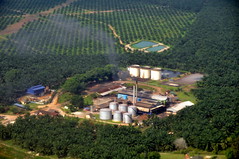Palm Oil processing gives rise to highly polluting waste-water, known as Palm Oil Mill Effluent (POME), which is often discarded in disposal ponds, resulting in the leaching of contaminants that pollute the groundwater and soil, and in the release of methane gas into the atmosphere. POME is an oily wastewater generated by palm oil processing mills and consists of various suspended components. This liquid waste combined with the wastes from steriliser condensate and cooling water is called palm oil mill effluent (POME). On average, for each ton of FFB (fresh fruit bunches) processed, a standard palm oil mill generate about 1 tonne of liquid waste with biochemical oxygen demand (BOD) 27 kg, chemical oxygen demand (COD) 62 kg, suspended solids (SS) 35 kg and oil and grease 6 kg
POME has a very high Biochemical Oxygen Demand (BOD) and Chemical Oxygen Demand (COD), which is 100 times more than the municipal sewage. POME is a non-toxic waste, as no chemical is added during the oil extraction process, but will pose environmental issues due to large oxygen depleting capability in aquatic system due to organic and nutrient contents. The high organic matter is due to the presence of different sugars such as arabinose, xylose, glucose, galactose and manose. The suspended solids in the POME are mainly oil-bearing cellulosic materials from the fruits. Since the POME is non-toxic as no chemical is added in the oil extraction process, it is a good source of nutrients for microorganisms.
Currently, recovery of renewable organic-based product is a new approach in managing POME. The technology is aimed to recover by-products such as volatile fatty acid, biogas and poly-hydroxyalkanoates to promote sustainability of the palm oil industry. In addition, it is envisaged that POME can be sustainably reused as a fermentation substrate in production of various metabolites through biotechnological advances. In addition, POME consists of high organic acids and is suitable to be used as a carbon source
Anaerobic digestion is widely adopted in the industry as a primary treatment for POME. Biogas is produced in the process in the amount of 20 m3 per ton FFB. This effluent could be used for biogas production through anaerobic digestion. At many Palm-oil mills this process is already in place to meet water quality standards for industrial effluent. The gas, however, is flared off. Liquid effluents from Palm Oil mills in Southeast Asia can be used to generate power through gas turbines or gas-fired engines.



Good day…
I am Mei from MVANCE ENGINEERING SDN BHD.
I am from palm oil industry. The wastewater has very high concentration of COD and BOD. With stringent regulations implemented by the Department of Environment, we need to meet a certain required standard. However, biogas production is our main concern.
I am very much delighted to know if your company is able to provide a very good solution to my above mentioned problems.
Please find the following as the characteristics of the wastewater. And thus, you may proceed with a proposal if there are no doubts. Do let me know if you have any questionairres.
Capacity of mill: 60 t/hr
Volume of wastewater to be treated: 1000 m3/day
pH: 4-4.5
temp of wastewater: 80-90 Celcius
COD: 75000-90000 mg/L
BOD: 25000-30000 mg/L
Oil and grease: 5000 mg/L
Total solid: 40000-45000 mg/L
Total suspended solid: 18000-20000 mg/L
Thanks
Im Fatma student of Industrial chemistry n Im doing research about the treatment of raw POME. I found that it’s hard to find the specific value of the viscosity of raw POME even though I’ve read about the characteristic of raw POME. So now I wonder is there any specific value of POME viscosity?
thank you
Hi, I am also searching for the viscosity of raw POME, can u share your info to me? appreciate your help. Thank you.
hi im too looking for the pome viscosity…any theoretical or experimental values?
would u help me share ur info?\
Please forward your mail id .. we will propose our technology for the POME treatment . Thanks,
Hello Seshadhiri, S.O.S. Can you propose to me the effective ways for the POME treatment for my masters study. i really appreciate your help.
Dear Sir, We are Afdal Success Sdn Bhd , We manufacture , , sell , service high speed decanters.. We would like to introduce our 2 phase decanters for the dewatering of pome ponds and removing solids from the ponds. We would like to put a trial unit in any of your upcoming prioects ias a solution for dry solids removal to fertilizer subsstance and claim the zero discharge system. Thank yoi and pkeas visitvour website for further info.
Thank you for the information of POME. I want to know the effect of oil and grease in POME to the river when POME are discharge to the water body.